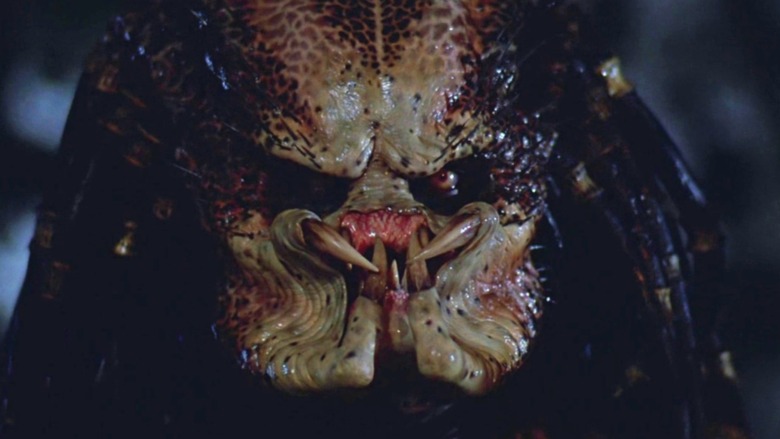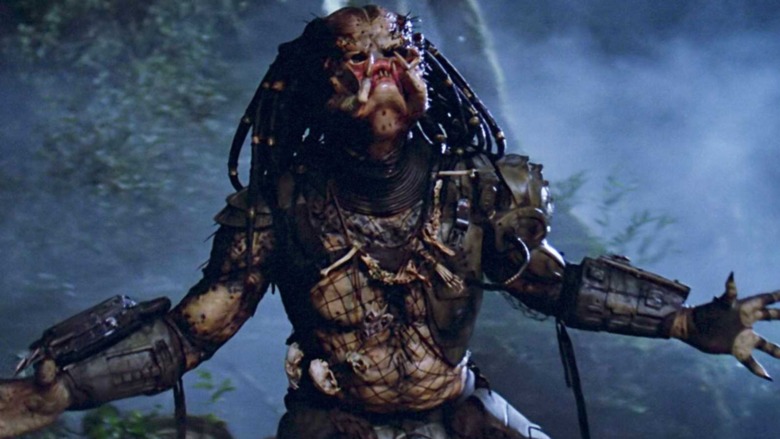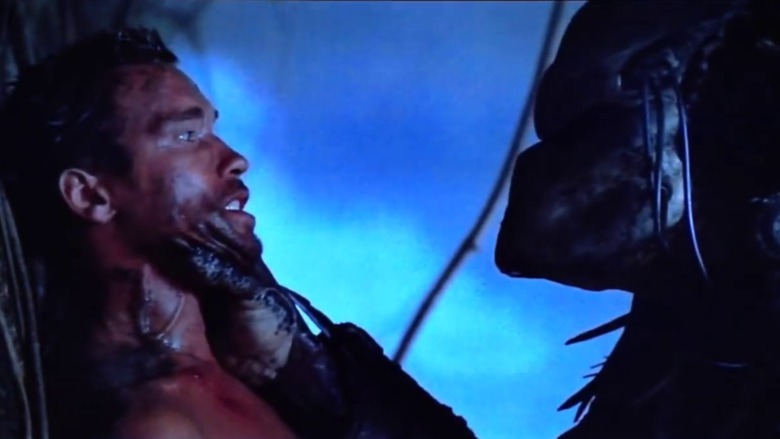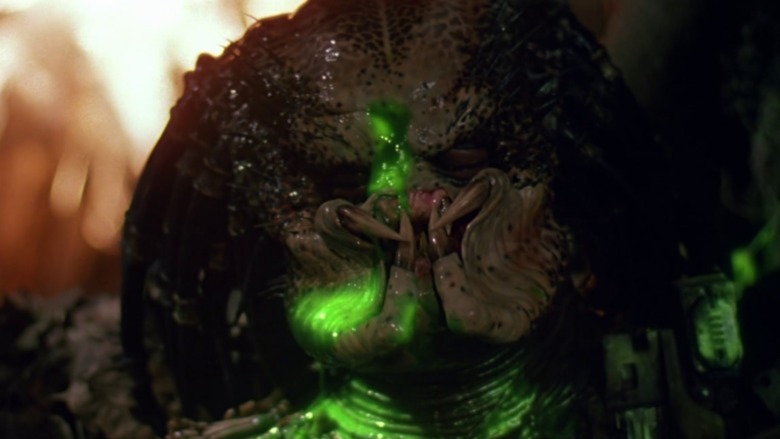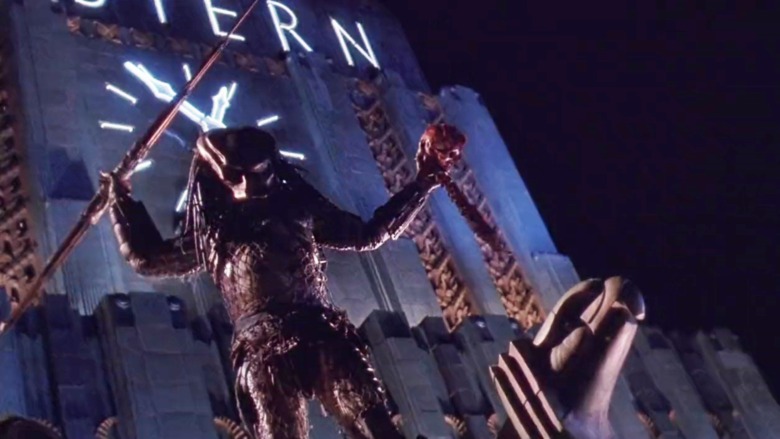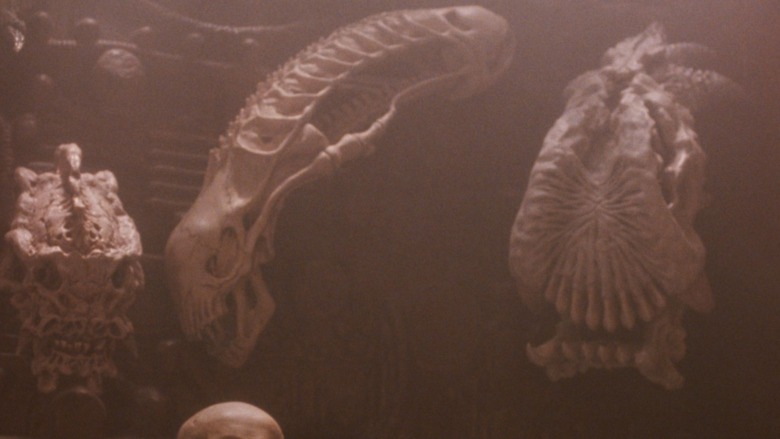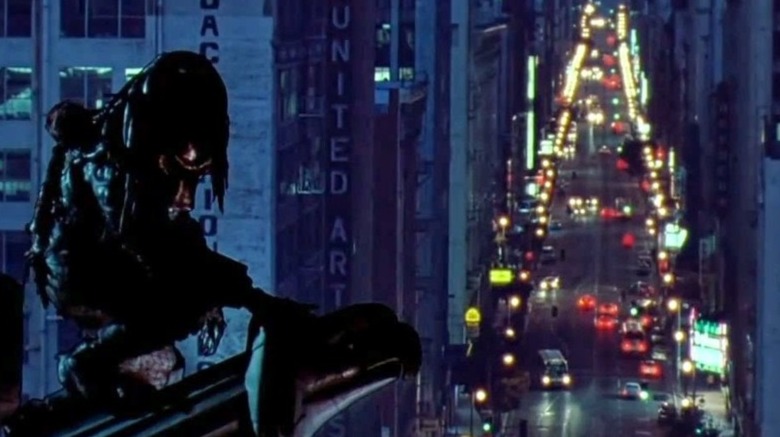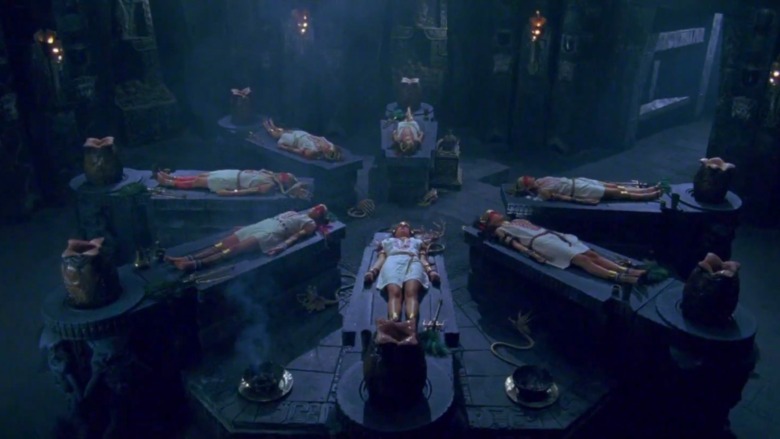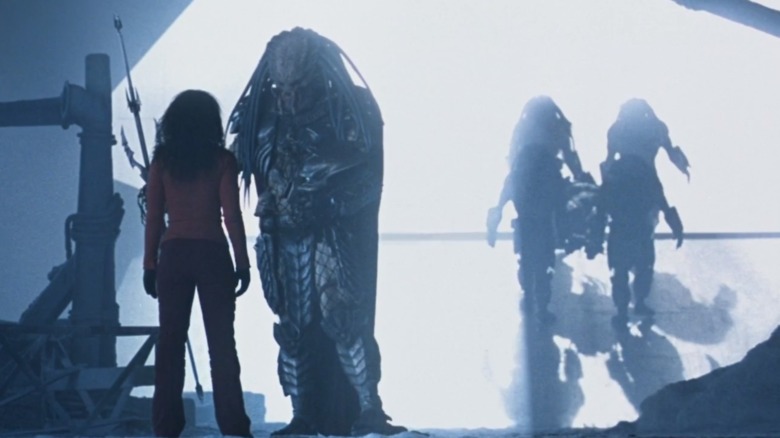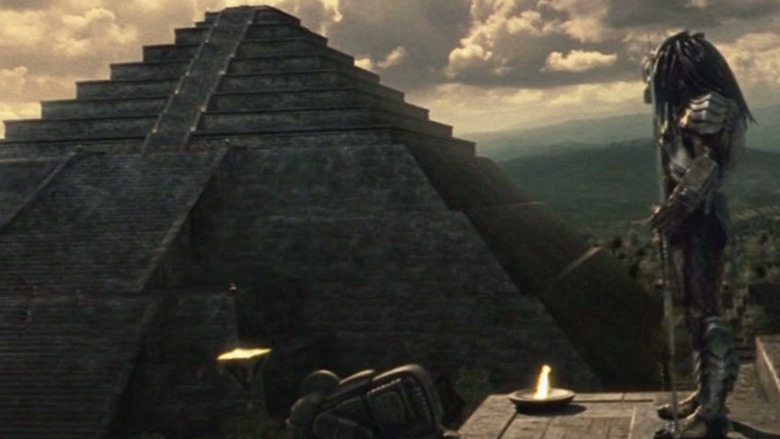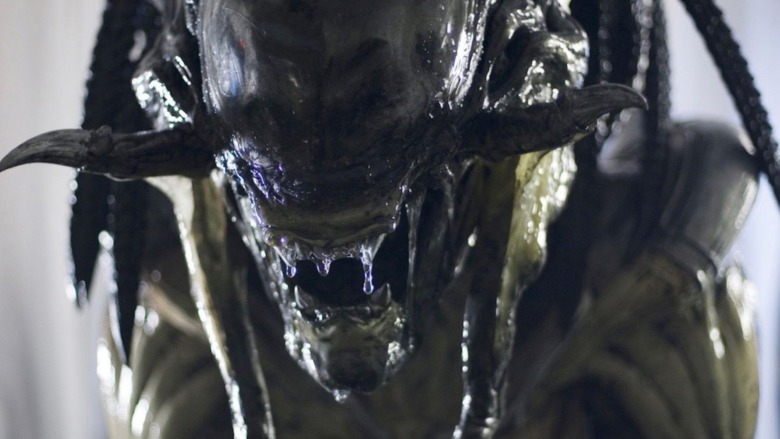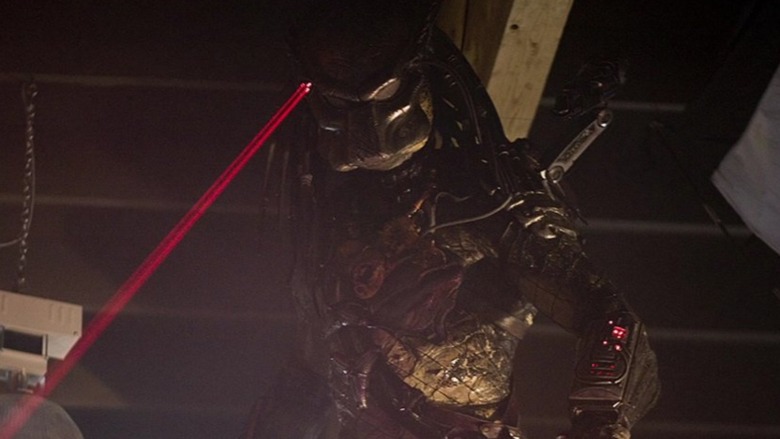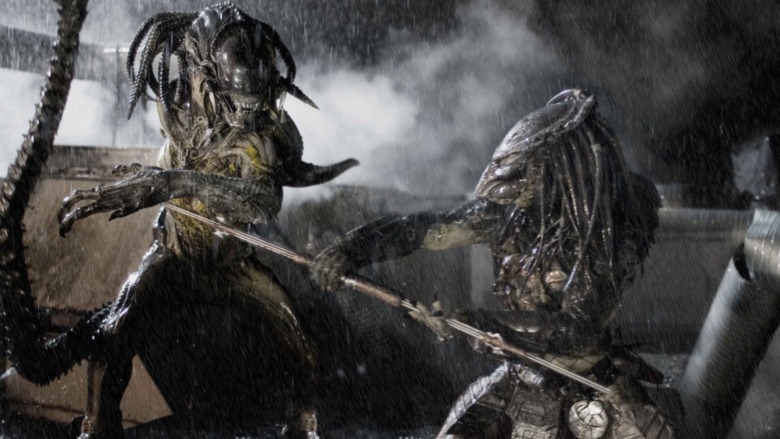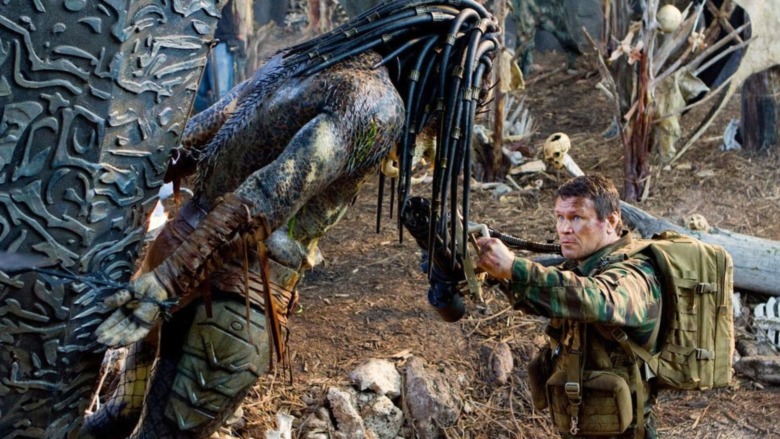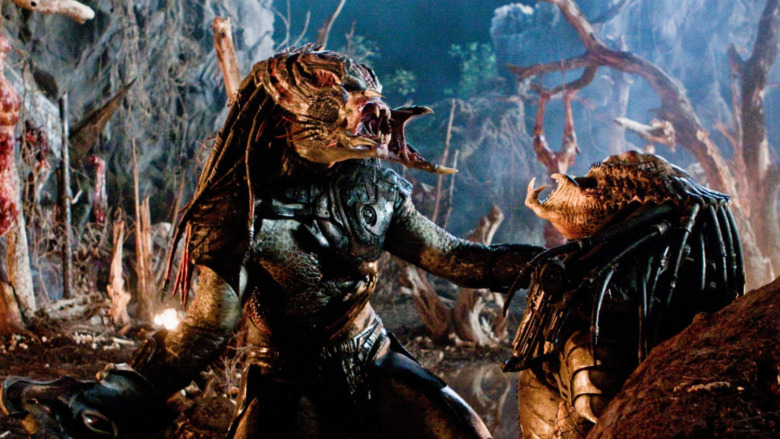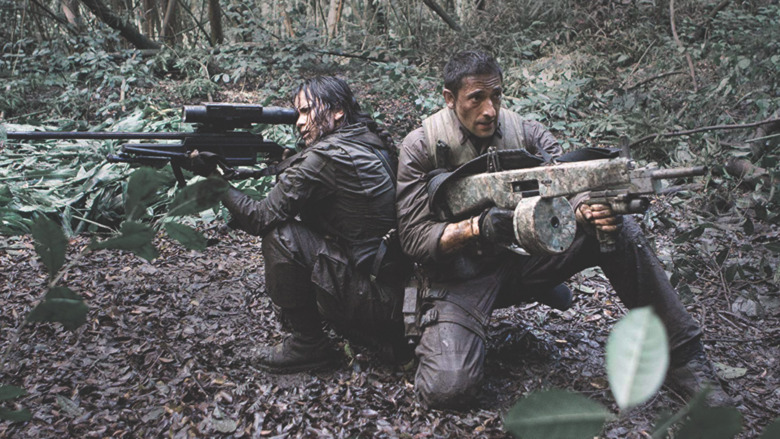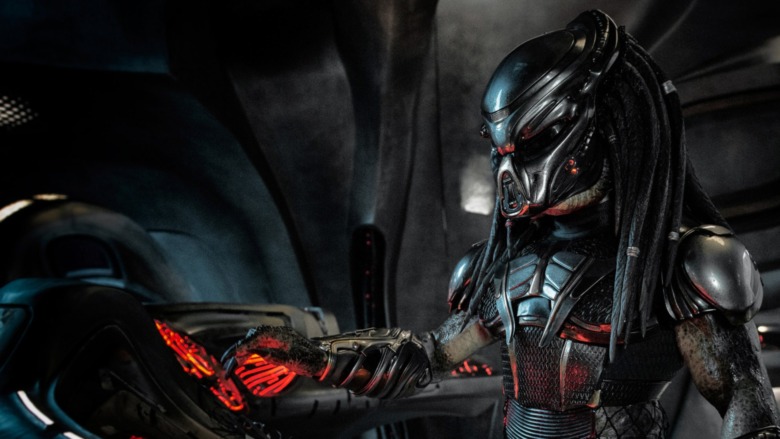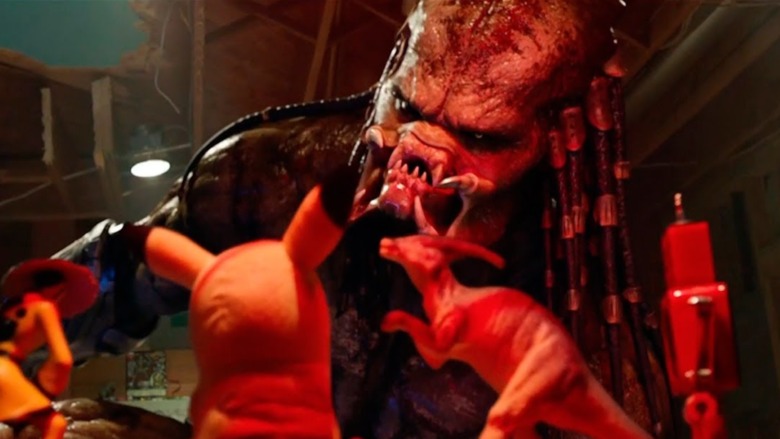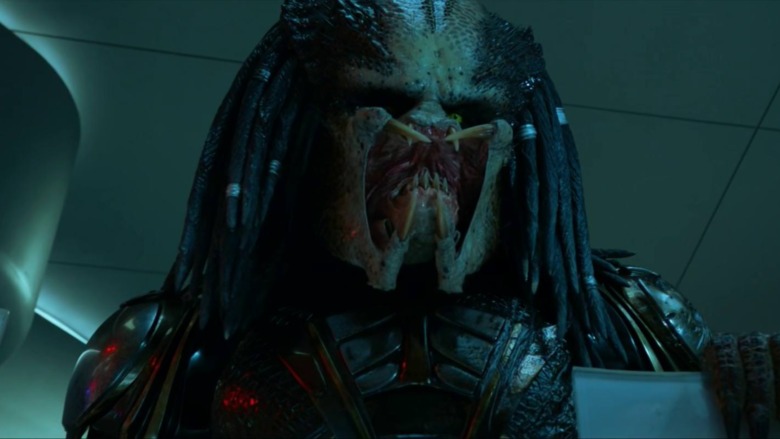Every Predator Movie Ending Explained
The "Predator" film series introduced one of the most iconic extraterrestrial threats in cinema history, the Yautja — better known as the Predators — who first appeared in the 1987 action-horror classic "Predator." They have a brutal hunting ethos, cloaking technology, unique weapons, and a vicious, mandible-covered face; simply put, the Yautja are one extraterrestrial species you don't want to encounter.
At the same time, the movies' production history leaves a complex legacy for this franchise. There's sometimes considerable time in between sequels, a range of gradual mythos additions to the film series, and a pair of "Alien vs. Predator" films whose canonical status has long been in dispute with regards to the major "Alien" and "Predator" films. How are we to pull apart the films, their endings, and what they add to the franchise's lore?
Let's break down every film in the series to its foundations, shining a light on that very question. Here's what each entry in the "Predator" series means in the context of the franchise, including what it adds to the bigger-picture mythos.
Introducing 'Predator'
"Predator" follows an elite team of mercenaries on a rescue mission deep in the heart of a guerilla-controlled area in Central America. The team, led by ex-special forces Major Alan "Dutch" Schaefer, quickly finds unexpected helicopter wreckage, a slew of skinned corpses, and evidence of a killer that leaves no tracks. They make quick work of a group of insurgents, taking one unarmed female insurgent, Anna, captive. Col. Al Dillon, a CIA operative assigned to the team, admits the mission was a setup intended to trick the squad into killing the guerillas, rupturing the long friendship between Dillon and Dutch.
As the team moves forward, they find themselves progressively under attack from an unseen foe, who starts to pick off members of the mercenary team one by one. Its ability to enter the area without triggering traps causes suspicion that the foe may not be human. Anna tells Dutch of a local legend: a creature that hunts humans for sport. Eventually only Dutch and Anna remain, and Dutch realizes the creature only targets armed prey: he sends Anna off alone so she'll be safe from its attacks.
Dutch becomes covered in mud, discovering that the mud allows him to hide from the entity as it moves on. Dutch proceeds to place traps, and he is able to damage its cloaking device, but he is still overcome by what we discover is the Yautja. It drops its armor and weapons for a fair fight, and Dutch nearly loses before catching the Predator in a trap. The fallen Yautja activates a self destruct device, laughing maniacally. Dutch realizes the alien's ploy, and narrowly escapes, fleeing just before the creature's self-destruction.
'Predator' Worldbuilding
As our introduction to the species, "Predator" demonstrates a number of characteristics of the creature. Visually, they're adorned in seemingly light but powerful armor, and have menacingly tough alien bodies with aggressive mandibles, distinctive dreadlocks, and neon-green blood. They have a high-technology spacefaring civilization with an advanced and distinct language, deadly weapons (including shoulder-mounted laser cannons and distinct wrist mounted dual-blades), cloaking technology, and they're smart, strong, adaptive warriors who can spot and create traps.
Culturally, we infer they have a hunting-oriented intergalactic civilization, a facet that affects everything from their culture to their technology. The Yaujta are here killing (only) armed prey for sport, often hunt alone, skin their quarry, and take trophies. If their hunt fails and they're facing death, they'd rather kill themselves than lose, be killed, or call for help — and their method of suicide is to try one last ditch effort to kill their quarry. We learn more about their hunting motivations in future films, but at this point in the franchise, we can only infer that such a hunt was the Predator's sole motivation for traveling to Earth.
The Legacy of 'Predator'
In addition to the obvious contributions "Predator" made in introducing us to the Yautja, we also learn a lot of subtle things about the personalities of the species in the film's end. Beyond only facing armed combatants and hunting for sport, the Yautja actually enjoy the challenge — putting down arms and armor to face a worthy foe. They also exhibit a menacing joy in getting that last one-up kill on their prey, as shown by the Predator's menacing laughter when it hit its self destruct button. The film set the tone for effectively every subsequent portrayal of the entity, and its legacy affects the series.
The film received mixed critical reviews in its day (though it's viewed much better, now) but its box office success was undeniable, netting $98 million on a production budget of $18 million. The film cemented the Predators as an iconic movie monster/extraterrestrial species, fueling 20th Century Fox to greenlight three direct sequels over subsequent decades alongside the two "Alien Vs. Predator" sequels, as well as a host of other media and memorabilia including video games, novels, comics, and toys. In short, "Predator" is certainly successful in a host of ways, launching an entire franchise and setting up one of cinema's most iconic creatures.
Introducing 'Predator 2'
The second film — appropriately titled "Predator 2" — shifts the action into urban territory. In the middle of an L.A. heat wave, a gang war brings the involvement of LAPD Lieutenant Mike Harrigan and his team. The cops barge into a hideout to find a Colombian gang slaughtered, and Harrigan follows the panicked survivor to the roof to see the vague, transparent silhouette of a large invisible man, dismissing it as a result of the heat. At his precinct, Harrigan's introduced to Special Agent Keyes, the leader of a task force investigating the cartels.
That night, another gangland murder is interrupted by the Predator. Harrigan and his team investigate the scene of the crime — a drug lord's penthouse — and find an alien spear. Keyes enters and threatens Harrigan to stay away, but Harrigan still returns with Det. Danny Archuleta (who is killed by the Predator while retrieving the weapon). Harrigan vows to avenge Danny. Two members of Harrigan's team are later attacked by the Yautja. He pursues the Predator before being captured by Keyes' team, who explains that the Predator is a camouflaged alien hunter who prowls areas with armed conflict, and he's hunting the alien.
Keyes' team sets a trap, but they're easily overcome by the Yautja, and Harrigan pursues the alien himself. The Predator closes in on Harrigan before Keyes intervenes, which leaves Keyes dead. The fight between the Predator and Harrigan continues downward into tunnels beneath the city, where Harrigan discovers the Yautja spacecraft and its skull-adorned trophy room — which happens to include a skull that looks like it belongs to a Xenomorph from the "Alien" franchise. He manages to kill the Yautja with its own weapon, causing a group of Predators appear, collect the fallen alien, and present Harrigan a trophy. Harrigan escapes as the ship takes off.
'Predator 2' Worldbuilding
"Predator 2" made a number of important leaps for our understanding of the mythos of the Predators, their behavior, their society, and more. First, it shifted the action from the remote jungles of the first film to deep urban territory, widened the scope of the types of warrior-combatant prey we know Predators hunt, and showed that they're as willing to hunt in crowded city centers as they are in remote combat zones.
While the film also added new weapons to their arsenal, including Smart Discs that can fly, kill, and return to their controller. The film also shows that lone-hunter Yautja don't travel to a planet unobserved, but are instead in contact with other members of their species. These other hunters will take the body of a fallen comrade 'home' upon its failure to self-destruct, a unique evolution of their culture that adds significant ritual to their hunts. The film also explains the species' propensity to travel to this planet to hunt humans for sport, particularly in combat zones (both attributes that were present in the first film but not explicitly confirmed), and that at least some groups in the government are aware of the predation.
Finally, in showing the ship's trophy room and the Xenomorph skull within it, it suggests that the "Alien" and "Predator" worlds take seemingly place in the same universe, and that the Yautja hunt Xenomorphs, too ... and by implication, other species around the galaxy. While this had been introduced in its comic book lore, it's the first cinematic introduction of that concept.
The Legacy of 'Predator 2'
The success of "Predator" all but guaranteed a sequel, and the resulting film shifted the action into urban zones, solidified a lot of the mythos that the first leaves implicit, added to the Yautja's weaponry and tactical prowess, and implicitly provided the intellectual underpinning for the "Alien vs. Predator" spin-off films that immediately followed. It evolved our Yautia cultural understanding: They're not rogue, isolated hunters, but active members of an entire alien civilization built around the hunt.
Despite the film's current cult classic status, "Predator 2" suffered mostly negative reviews in its day and fared much more poorly at the box office than its predecessor, netting just under $55 million on a larger budget of $35 million. The film's relatively lackluster performance at the time effectively paused the franchise until the "Alien vs. Predator" spinoff franchise hit in 2004. While filmmaker Robert Rodriguez penned a standalone sequel in 1994, his sequel wouldn't get made until 2010's "Predators," and it would be a pretty different film by then anyway. In short, "Predator 2" proved mighty influential in its cementing many aspects of Predator lore, but its relative lack of success paused the individual franchise for some time.
Introducing 'Alien vs. Predator'
In 2004's "Alien vs. Predator" — often referred to just as "AvP" — wealthy industrialist Charles Bishop Weyland assembles a team to investigate a mysterious heat signature beneath an island north of Antarctica. Meanwhile, a Predator ship reaches Earth orbit and fires an energy beam straight at the heat signature's location, creating a 'tunnel' to its source: an ancient pyramid. The team finds the tunnel and uses it to reach the pyramid, finding evidence of ancient humans — with ruptured rip cages — in what seem to be sacrificial chambers.
Three Predators descend from the ship and kill team members on the surface above the tunnel, while the team below unintentionally activate devices within the pyramid, reanimating a Xenomorph Queen from stasis, who produces a host of Xenomorph eggs. Facehuggers attach to humans trapped in the sacrificial chamber, quickly maturing into adult Xenomorphs while the Weyland team presses on unaware. Conflict erupts and escalates between the Xenomorphs, humans, and the Yautja, and one of the Yautja — known as "Scar" — finds himself attacked by a facehugger.
Hieroglyph translations reveal that Predators have been visiting Earth for thousands of years and were worshipped as gods, teaching early humans how to build pyramids. They periodically return as part of a hunting ritual where humans are sacrificed to produce Xenomorphs as prey. Weyland team guide Lex and Scar form an alliance, planting Scar's self destruct device in the Xenomorph hive to destroy the remaining Xenomorphs and eggs. The Queen survives, but the pair defeat her while Scar dies from wounds received in battle. A Predator ship uncloaks as Yautja take Scar's body and present Lex with a spear before ascending. The film ends as we watch a Predalien — a combination of Predators and Aliens — burst from his chest.
'Alien vs. Predator' Worldbuilding
Alien vs. Predator adds a lot to the established Yautja as established in prior films. Most notably, it's the first film to establish that the Predators have been hunting on Earth for thousands of years. And more than that, they were instrumental in the earliest human civilizations' development of complex pyramid-producing cultures on multiple continents and worshipped as gods — effectively, they were a major factor in the development of early human culture and, possibly, religion.
The importance of Earth for the Predators is another important element to the mythos that is added to this film; far more than one hunting ground of many, Earth is at least one special location where Yautja rites of passage were conducted to facilitate the Xenomorph hunt. Technologically, the film showcases the throwable weapon known as the Shuriken, similar to the Smart Disc except for the addition of a set of retractable blades.
The Legacy of 'Alien vs. Predator'
The spinoff "Alien vs Predator" franchise has a complicated legacy in the overall "Predator" universe. Long treated as non-canon, the two-film series introduces a variety of aspects to "Predator" and "Alien" mythos–perhaps the biggest part being the Yautja being worshipped among early humans, sacrificing them for early Xenomorph hunts, and teaching them to build pyramids. While "Predator 2" suggested the two species share the same universe, it didn't necessarily mean "AvP" is canon... until a detail in 2018's "The Predator" (the fourth film in the "Predator" standalone franchise) subtly reinforces it. In that movie, Casey Bracket is shown the Alien tail Combi-spear crafted for Lex in "AvP," implicitly confirming their canonicity in the official "Predator" universe. Though, given Ridley Scott's antipathy towards the crossover and the "Prometheus" and "Alien: Covenant" detail differences, it's safe to say they're not canon in the "Alien" franchise.
That said, in "Alien vs Predator" we learn of the centrality of Earth and the Xenomorphs to Yautja culture, along with their long history with humanity. If the canonical status holds up in future entries, this is huge for the franchise mythos. Additionally, despite its critical detractors, the film performed quite well at the box office with $172 million worldwide on a $70 million budget, breathing new life into the "Predator" and (ironically) "Alien" franchises. That said, its influence is nonetheless still controversial — for "Predator" purposes we can safely say that the current state of the franchise validates its additions to Predator lore (however subtle those validations are).
Introducing 'Alien vs. Predator: Requiem'
"AVP: Requiem" begins exactly where "AVP" left off — on-board the Predator ship containing the Yautja Scar from the prior film. A hatched Predalien emerges from Scar's fallen body, rampaging through and crashing the craft outside a Colorado town. The ship's distress signal is received by the elite Predator, Wolf, who travels to Earth to eradicate the Predalien and any facehuggers that escaped. On Earth, a number of escaped facehuggers find hosts, as Wolf lands and starts to clean up evidence of the alien menace. Wolf tracks a number of Xenomorphs into the town sewers, and several escape into the town above.
Meanwhile, a set of the human protagonists of the film regroup at a local sporting goods store, and the National Guard arrive only to be slaughtered by the escaped Xenomorphs. Wolf and Xenomorphs enter and battle inside the store as the surviving humans escape. The survivors use the Guard's communications equipment to contact the military and ask for evacuation instructions, and are directed to the center of town for air evac. The human survivors split off, some moving towards air evac and the others moving to use the hospital's helicopter to escape the area.
The hospital splinter group find's the hospital overrun by Xenomorphs and the Predalien, and Wolf arrives to kill a number of the Xenos (accidentally killing one of the human survivors and losing a blaster in the process). The humans grab the blaster, and conflict rages between the Xenomorphs, Wolf, and the human survivors. The latter fight their way to the roof, board the chopper, and take off — all while Wolf and the Predalien emerge and engage in final combat on the roof, mortally wounding each other. Meanwhile, the splinter group of survivors waiting for military evac in the center of town finds that the military lied — instead of evacuating, the military bombs the city to eliminate the alien threat. The shockwave crashes the escaping hospital helicopter, where the remaining survivors are rescued by awaiting military forces. Soon, Wolf's recovered plasma blaster is presented to a woman named Ms. Yutani — a character whose name signifies her deeper connection to the "Alien" franchise.
'Alien vs. Predator: Requiem' Worldbuilding
Building directly off "Alien vs. Predator," "Alien vs. Predator: Requiem" doesn't build the mythos as much as it demonstrates it. We do discover that Predators will call on the assistance of others in case of emergency (particularly when that emergency is of the Xenomorph variety), and that the species will sometimes attempt to clean up evidence of their activities. Additionally, they seem intent on preventing Xenomorphs from escaping to dominate a planet (or at least Earth). We also see Wolf use weapons that we have not seen in use by other Yautja, including the Yautja Whip, a quick handheld bullwhip (notably resistant to Xenomorph acid blood) that can wrap around a target and cut it in half, laser mines, and the Power Punch Glove that amplifies the Predator's punching power.
Finally, we see extraterrestrial plasma pistol used by Wolf given to Ms. Yutani of the Yutani Corporation, a Japanese cybernetics corporation 'officially' founded in 2074 but possibly in operation in some capacity long before that. The company's 2099 merger with the Weyland Corp produced the Weyland-Yutani Corporation we see in the first "Alien" film from 1979.
The Legacy of 'Alien vs. Predator: Requiem'
"Alien vs. Predator: Requiem" directly continues the prior controversial spin-off, building little but demonstrating much that was established in prior "Predator" films ("AvP" included). Like "AvP," whether or not it's contributions are canon hinges entirely on the overall status of the spinoffs. It does evolve the culture some: we see that the Yautja may sometimes clean up the evidence of their hunts (and mistakes) and hide their presence from general hunted populations, and they act particularly quickly when their own species is corrupted by Xenomorph infestation.
The film was overall received more poorly than any other "Predator" film, yet it earned a higher profit margin than the preceding spinoff at a $128 million take on a $40 million budget. The near-universally poor critical reception put the directors' plans for a third spinoff on indefinite hold, and Fox instead decided to move forward with a long-shelved Robert Rodriguez story for a new standalone film starring the Predators. Nonetheless, its contributions to Yautja weaponry and culture (and a cool Predalien design) have stayed with the franchise (even if the Predalien hasn't been used in film since).
Introducing 'Predators'
"Predators" begins with mercenary Royce parachuting into an unfamiliar jungle alongside a variety of other humans. As it turns out, they're equally confused by their arrival to this mysterious place, and they're also all armed and lethal killers — like a member of the Yakuza, a Russian soldier, and a sniper named Isabelle. Among them, however, is one person who isn't a killer, but rather is a doctor named Edwin. When night comes they see an alien sky, for the first time realizing they're no longer on Earth. The makeshift teammates soon find themselves attacked by four-legged extraterrestrial beasts before a whistle calls them off.
The team discovers a captive Predator, but are soon attacked by three massive 'Super Predators' (known as the Tracker, Berserker, and Falconer). The human team flees, and eventually encounter Ronald Noland, a lone U.S. soldier who survived on the alien planet by looting and hiding. Noland reveals the planet is a Predator game reserve where Yautja train against deadly warriors and creatures. There, the Predators hunt in threes, and the smaller and larger Yautja feud. Noland betrays, traps, and attempts to kill the others for their gear, but Royce triggers an explosion that brings the Predators to the compound, freeing the humans.
Conflict between the Predators and the humans eventually kills Noland, several team members, and the Tracker and Falconer Yautja. Edwin becomes injured and Isabelle refuses to leave him, but Royce moves on to free the captured Yautja in hope of escape. The Berserker catches Isabelle and Edwin, trapping them in a pit. Royce proceeds to free the smaller captured Yautja, who activates a ship and programs its return to Earth. The Berserker arrives, kills the smaller Yautja, and blows up the ship. Royce, having changed his mind to return for the others, discovers Edwin is more predatory than anyone had initially thought, as he's revealed himself to have been a serial killer back on Earth. Knowing Edwin's far more than an innocent doctor, Royce uses Edwin as grenade-trapped bait. The Berserker triggers the trap, and Royce and Isabelle kill it. The film ends with the pair looking at the alien sky as more parachutes fall.
'Predators' Worldbuilding
"Predators" adds a large array of elements to the mythology of the "Predators" universe. First, and perhaps most notably, is that the Predator species has two distinct subspecies with a long history of antagonism (and a considerable size difference). The smaller group, introduced in the 1987 film "Predator," is often referred to as the 'Jungle Hunter Clan,' while the Super Predators are larger and more muscular with similar technology and language.
We also learn that while 'Jungle Hunter' Yautja frequently travel across the galaxy to hunt various prey, Super Predator Yautja have a planet of unknown location where they regularly deposit and hunt dangerous species. (Jungle Hunter Yautja may also hunt this way, but the film neither confirms that practice nor why the Jungle Hunter Yautja was there). This is also the first instance in the film series where Yautja are seen hunting with quadrupedal hunting animals, a facet of their hunting culture that hasn't yet been shown onscreen.
Finally, there's the case of Edwin, who we discover is a serial killer — the Yautja have long been known to hunt armed combatants in combat zones, situations where predation is easily visible for a Predator to track, find, and hunt armed prey. With Edwin, we discover that the Predators' methods of reconnaissance are much more sophisticated. While it is unexplained how they do so, they were able to discover that Edwin was a killer despite his methods being less visible than the armed combatants that Predators typically hunt.
The Legacy of 'Predators'
With "Predators," Fox reinvigorated the franchise, reorienting it away from the "AvP" spinoffs and towards new individual "Predator" outings. The film added a lot to the mythos: an entirely new race of Yautja, a game reserve planet, a new level of detail in the Yautja's search for deadly combatants, and hunting animals, backed by strong performances and lovely cinematography.
The film grossed $127 million on a $40 million budget and received significant critical acclaim, the most acclaimed in the film franchise since the 1987 original. Super Predators have not appeared in a subsequent film, but a Super Predator-like Yautja was seen in the one-shot film sequel comic book "Predators: Surviving Life," containing a four-armed Predator that otherwise resembles the trio. While this film's cinematic sequel "The Predator" does contain a massive Predator with genetically modified DNA (and that genetic modification was originally in the script for "Predators" but didn't make the final cut), it's unclear if there is a connection between the Super Predators and that film's massive Yautja. In short, "Predators" breathed new life into the series while both adding to and clarifying the mythos considerably — but it's unclear what effect that will have on the future of the franchise and its Yautja.
Introducing 'The Predator'
"The Predator" opens with one Yautja ship fleeing another before crash landing on Earth, interrupting Army Ranger Quinn McKenna's mission. The alien attacks his team before he incapacitates it with its weaponry and flees with Yautja armor. McKenna manages to send the technology clandestinely home. When he returns, he's interrogated by agents from Project Stargazer (led by government agent Will Traeger) and put on a military prison transport. Biologist
Casey Bracket arrives at a Stargazer research lab to investigate the captured Predator body and the inexplicably spliced DNA its body contains. The Predator wakes up, rampages, and flees. McKenna and the transport's other soldiers hijack their prison transport and proceed to McKenna's house (picking up Bracket on the way).
McKenna and the escaped soldiers discover that McKenna's autistic son Rory had found and left the house actually wearing the Yautja armor. McKenna and the soldiers leave, eventually finding the boy before the Predator emerges and chases McKenna, Bracket, and Rory into a nearby school. The three attempt to give the Predator its armor back before a larger, more powerful Predator emerges and kills the first. The humans flee. Bracket gathers that the Predators may be attempting to improve themselves through genetic engineering (explaining the first Predator's human DNA and the rigid exoskeleton of the second).
McKenna, Brackett, and the escaped soldiers are discovered and interrogated by Traeger and his agents, who have taken Rory upon discovering that he gained knowledge of the aliens while wearing the Predator armor. Traeger and Rory board the Predator's ship, while McKenna and the escaped soldiers ambush Traeger's agents before being ambushed by the larger Predator in turn. The larger Predator kills several soldiers and agents and takes Rory to his ship, seeing his unique mind as an adaptation worthy of genetic incorporation (a plot point which, understandably, caused controversy upon the movie's release). The larger Predator attempts to take off before McKenna's allies ground the ship, and McKenna, Bracket, and Rory kill the Yautja with its own weapons. The film ends with the discovery that the first, smaller Predator was transporting to Earth a human-sized piece of advanced 'Predator' armor, labeled a 'Predator killer' suit.
'The Predator' Worldbuilding
Shane Black's "The Predator" introduces a few novel concepts that are new to the "Predator" film franchise. First, the film reveals that at some point the Yautja species began genetic engineering to incorporate the strengths of other species into their DNA. As shown in the film, it seems like a highly individualistic set of chosen adaptations — the two Predators we encounter are both genetically engineered but have wildly different attributes. The first is the smaller of the two, its own DNA spliced with human DNA. The second, by contrast, is much stronger and larger, with a tough exoskeleton in addition to other adaptations. Additionally, the film implicitly folds "Alien vs. Predator" into the "Predator" franchise through its highlighting a weapon exclusive to that film, reinforcing the addition of that film's massive contributions to Predator canon.
We also discover that the human/Yautja hybrid was on a mission to deliver the advanced, human-sized 'Predator Killer' armor, presumably to give humanity an advantage against a possible future invasion or against future Yautja hunters. The reason for this gift may be due to sympathies resulting from that specific Predator being partially human (we're left to speculate), but we at least know that the intentional hybridization of the Yautja species is yet another major development in the Predator mythos.
The Legacy of 'The Predator'
Shane Black's "The Predator" makes a few important explicit evolutions in Yautja history, including suggesting the canonicity of "Alien vs. Predator" and its developments. Beyond this, the film establishes that Yautja genetically improve and modify themselves on an individual basis (with both of the film's Predators having fully divergent genetic trajectories). "The Predator" is also intriguing for its suggestion that the Yautja may be interested in the future of humanity on a larger scale beyond the hunt, including potential genetic incorporation.
The film was a relatively modest success by Hollywood standards, delivering an $159 million global box office on an $88 million budget. Critically, if review aggregator Rotten Tomatoes is a guide, the film stands at the low rating of 33%. Believe it or not, this still makes it the third highest rated film in the entire series, including the "AvP" spinoffs. Overall, we have yet to see the full impact of the film's legacy, including the genetic engineering and the potential for a larger Yautja threat, but its contribution to their cinematic mythos is definitely worth thinking about.
